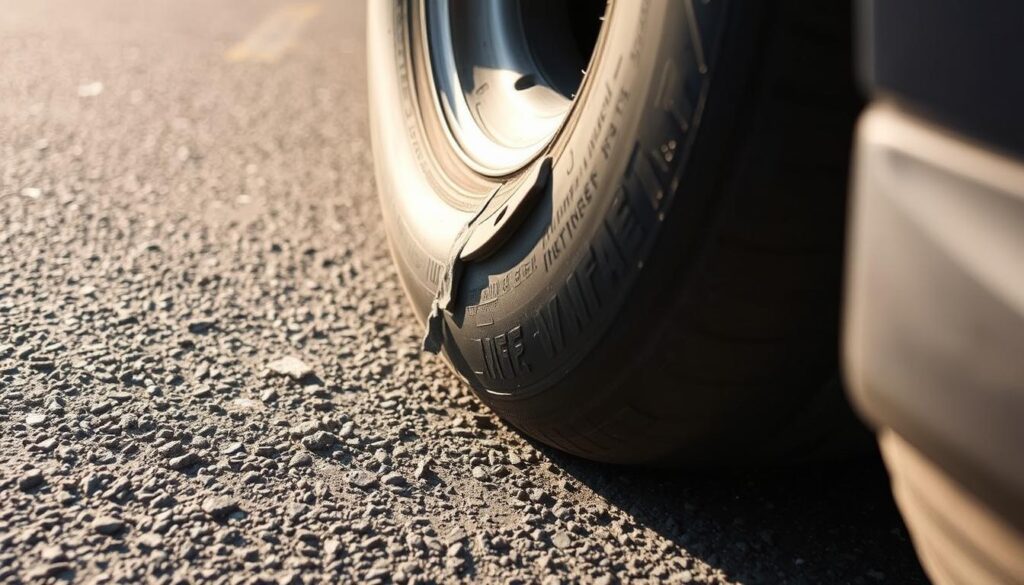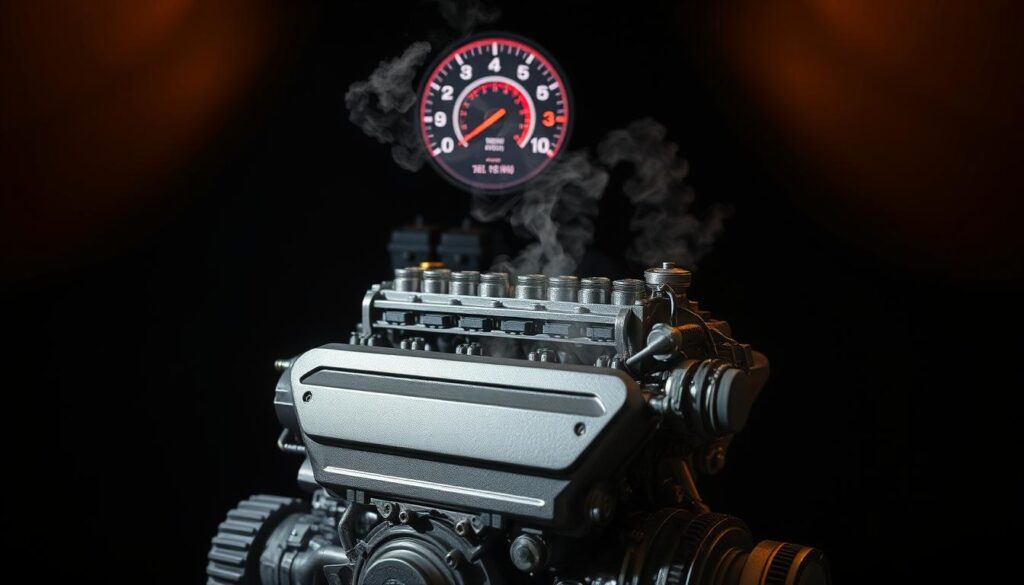Ever wondered what might be hiding under your car’s hood? It could be waiting to ruin your day. Knowing the top 10 car problems is essential for every driver. This guide will teach you how to spot and solve these issues.
By staying proactive with maintenance, you can dodge bigger problems later. Whether it’s a flat tire, dead battery, or engine issues, knowing how to fix them saves time and money.
Key Takeaways
- Knowing common car problems can help prevent costly repairs.
- Routine maintenance is key to extending your vehicle’s life.
- Being aware of warning signs can save you from breakdowns.
- Understanding basic fixes empowers you to handle minor issues.
- Consulting a professional is important for complex problems.
Understanding Common Car Problems
As a car owner, knowing about common car issues is key. Problems like engine overheating, flat tires, and worn brakes might seem minor at first. But ignoring them can cause bigger problems later.
Regular checks are important to spot early signs of trouble. This includes strange noises or dashboard warning lights. These signs can help you catch issues before they get worse.
Having a car maintenance checklist is a great idea. It helps you stay on top of routine tasks. This includes checking fluids, brakes, and tire pressure. By being proactive, you can fix small problems before they become big ones.
Staying alert to your car’s health ensures safer and smoother drives. It’s all about being proactive and keeping your vehicle in good shape.
Flat Tires and Their Solutions
Flat tires are a common problem for drivers. They can happen due to many reasons like punctures, leaks, or just wear and tear. Knowing why they happen can help you avoid them on the road.
Common Causes of Flat Tires
- Punctures from nails or sharp objects
- Under-inflation leading to tire damage
- Wear and tear from insufficient tread depth
- Sudden temperature changes affecting tire pressure
How to Fix a Flat Tire at Home
Knowing how to fix a flat tire at home can save you a lot of hassle. Here’s how to do it:
- Gather your tools: a jack, tire iron, and a spare tire.
- Loosen the lug nuts on the flat tire with the tire iron.
- Use the jack to lift your vehicle off the ground.
- Remove the flat tire and replace it with the spare.
- Tighten the lug nuts securely and lower the vehicle back down.
- Inflate the spare tire to the recommended pressure.

Dead Car Battery Issues
A dead car battery can be a big hassle. Knowing when your battery is failing can prevent you from getting stuck. Learning how to care for and replace your battery can make your car more reliable and last longer.
Signs of a Failing Battery
It’s important to recognize the signs of a dead car battery. Look out for these symptoms:
- Dimming headlights or interior lights
- Difficulty starting the engine, specially on cold mornings
- Unusual electrical issues like malfunctioning dashboard lights
- Corrosion around the battery terminals
If you see these signs, it might be time to figure out how to fix your battery or get a new one.
How to Maintain and Replace Your Car Battery
Keeping your battery in good shape is key. Here are some car maintenance tips:
- Clean battery terminals to prevent corrosion.
- Check connections and ensure they are tight.
- Test battery health during routine inspections.
If you need to replace your battery, pick one that fits your car. The process involves disconnecting the old battery, removing it, and installing the new one. This guide will help you keep your car running well.
Engine Overheating: Causes and Fixes
Engine overheating is a serious issue that can lead to significant car maintenance problems. It’s important to understand what causes it and how to prevent it. Common causes include low coolant levels, a malfunctioning thermostat, and a damaged radiator.
Monitoring your engine temperature regularly can help you catch issues before they get worse.

Routine Monitoring for Overheating Symptoms
To avoid catastrophic failures from engine overheating, it’s vital to be vigilant about your vehicle’s health. Here are key aspects to focus on:
- Check coolant levels frequently to ensure adequate fluid in the system.
- Monitor the temperature gauge on your dashboard during drives.
- Ensure that air can flow easily around the engine components.
Regular maintenance is key in preventing overheating. Scheduling radiator flushes and inspecting hoses can help. Being proactive lets you address issues before they become big problems. This way, you can fix common car issues effectively.
Brake Problems and Their Solutions
Brake issues are a big deal for car safety. They can be caused by worn-out brake pads, low brake fluid, or damaged rotors. Knowing the signs can help keep your brakes working well and keep you safe on the road.
Types of Brake Issues
It’s important to know what brake problems you might face. Listen for odd sounds when you brake. Squeaking or grinding means your brakes need a check.
Other signs include:
- Soft or spongy brake pedal – This could mean air in the lines or low fluid.
- Brake warning light – If it lights up, you need to check it out.
- Vibration during braking – This might mean your rotors need to be replaced or resurfaced.
Essential Brake Maintenance Tips
To avoid brake problems, follow some simple maintenance tips. These can help your brakes last longer:
- Check brake pads and rotors every 6,000 miles or as your car’s maker suggests.
- Look at brake fluid levels often and add more if needed to keep things working right.
- If you hear odd noises or notice changes in how your car brakes, get a pro to look at it.
- Swap out brake pads yearly, or sooner if they wear down fast.
Transmission Troubles: Identifying the Symptoms
Transmission troubles are common car problems. Knowing the symptoms and fixes can help you fix issues early. Spotting these signs can tell you about your car’s transmission health.
Common Signs of Transmission Problems
Look out for these signs of transmission issues:
- Difficulty shifting gears: Trouble changing gears smoothly or the car jumping out of gear is a big warning.
- Strange noises: Grinding, whining, or clunking sounds when shifting gears mean there’s a problem.
- Fluid leaks: Reddish or brown spots on your driveway could mean transmission fluid leaks.
- warning lights: Dashboard alerts, like the check engine light, often point to transmission issues.
- Unresponsive transmission: If your car doesn’t respond when you accelerate or has sudden delays, it might be the transmission.
Regular checks and maintenance of your transmission fluid can help your car’s transmission last longer. Knowing these signs helps you deal with a common car problem effectively.
The Top 10 Most Common Car Problems and How to Fix Them
In this car troubleshooting guide, we cover the top 10 most common car problems and how to solve them. Knowing these issues helps you fix them yourself or get help when needed. This way, you can keep your car in good shape.
- Flat Tires: Always check your tire pressure and look for damage. A tire repair kit can help you fix it yourself.
- Dead Car Battery: Spotting a failing battery is key, like slow engine start. Keep jumper cables ready for quick fixes.
- Engine Overheating: Watch your coolant levels and check your radiator for leaks. Keeping fluids right can prevent overheating.
- Brake Problems: Notice odd noises when braking. Regular brake checks keep them working well.
- Transmission Issues: Watch for slipping gears and strange sounds. Regular fluid checks can stop bigger problems.
- Electrical Problems: Keep an eye on warning lights and know common electrical issues. Replacing simple fuses is easy.
- Fuel System Problems: Notice any performance drops and check for leaks. Cleaning fuel injectors can boost efficiency.
- Suspension Issues: Listen for thumping sounds on bumps. Catching it early can save you from big repairs.
- Exhaust Smoke: Different smoke colors mean different problems. Fixing it fast is key to avoid engine damage.
- Air Conditioning Failures: Check for blown fuses and refrigerant levels. Simple fixes can make your car cool again.
With this guide, you can tackle the most common car problems. It helps you keep your vehicle in top shape.
Electrical Issues: Diagnosing and Repairing
Electrical problems in cars can be tricky. They can affect everything from the battery to lights and electronics. Knowing the signs of these issues is key to keeping your car running well. Spotting problems early can save you money and time.
Identifying Common Electrical Problems
There are several signs of electrical trouble in your car. These include:
- Flickering lights: This often suggests a faulty connection or a weak battery.
- Non-functional components: Units such as power windows or radio unexpectedly shutting down may signal deeper electrical issues.
- Burning smells: This can arise from short circuits or damaged wiring, necessitating immediate attention.
To avoid these problems, make sure connections are tight and clean. Check for corrosion around battery terminals regularly. Doing these checks during routine maintenance can help prevent bigger issues. Staying on top of small electrical problems can save you from big repair costs later.
| Electrical Issue | Signs | Preventive Measures |
|---|---|---|
| Weak Battery | Flickering dashboard lights; sluggish engine start | Regular battery testing; keeping terminals clean |
| Faulty Alternator | Dim headlights; electrical accessories malfunction | Regular inspections; replacing worn belts |
| Short Circuits | Fuses blowing frequently; burning odors | Avoid overloading circuits; inspect wiring |
Regular Maintenance to Prevent Common Car Problems
Regular maintenance is key to keeping your car running well and lasting longer. By following good car maintenance tips, you can avoid sudden breakdowns and expensive fixes. Simple tasks like oil changes, tire rotations, and brake checks are essential.
Having a detailed car maintenance checklist helps you keep track of important tasks. It ensures you don’t miss anything critical. Your checklist should include:
- Oil and filter changes
- Tire pressure and tread depth checks
- Brake performance evaluations
- Fluid levels inspections (coolant, brake, transmission)
- Battery health assessments
By following these steps, you can avoid many common car issues. This not only keeps your car running smoothly but also makes driving safer. Being proactive with maintenance saves you time and money over time.
| Maintenance Task | Frequency | Importance |
|---|---|---|
| Oil Change | Every 5,000 – 7,500 miles | Prevents engine wear |
| Tire Rotation | Every 6,000 – 8,000 miles | Ensures even tire wear |
| Brake Inspection | Every 10,000 miles | Maximizes stopping power |
| Fluid Checks | Monthly | Prevents system failures |
DIY Car Repair vs Professional Help
Choosing between DIY car repair and professional help is a big decision. Knowing your skills and the needs of repairs is key. Beginners should start with simple tasks like oil changes, air filter swaps, or fluid checks. This helps you know when to take on a job yourself or when to call a pro.
When to Attempt DIY Repairs
DIY car repair is great for simple tasks that can save money and boost your confidence. Try these easy repairs:
- Changing engine oil and oil filters
- Replacing windshield wipers
- Changing air filters
- Rotating tires
- Replacing light bulbs
These jobs need basic tools and knowledge, perfect for beginners. Always be safe and do your homework before starting any repair.
Benefits of Visiting a Mechanic
While DIY repairs are good, there are big benefits of visiting a mechanic. Some repairs need special skills and tools that DIYers might not have. Issues like:
- Transmission repairs
- Electrical system diagnostics
- Engine overhauls
- Brake system replacements
are complex and risky if not done right. A mechanic can do these jobs well, often with a warranty. Knowing when to get help is important for keeping your car in top shape.
Conclusion
Staying ahead of car maintenance is key to avoiding big problems. By spotting car issues early, you can fix them before they get worse. This article has shared tips on car care, from dealing with flat tires to fixing brake and transmission issues.
Using the solutions from this guide keeps your car running smoothly and safely. Regular checks and maintenance can make your car last longer and save you money on repairs. As a car owner, watching over your vehicle can help avoid sudden breakdowns.
By following the advice in this article, you’ll have a better driving experience. Stay alert, keep your car in good shape, and get help when you need it. Your safety and peace of mind on the road depend on it.
FAQ
What are the top 10 most common car problems?
Common car issues include flat tires and dead batteries. Engine overheating and brake problems are also common. Transmission troubles, electrical issues, and fluid leaks are frequent too. Worn brake pads, ignition system failures, and exhaust system problems round out the list.
How can I troubleshoot my car problems?
Start by noticing strange noises or warning lights. Use a car troubleshooting guide to find possible issues. Keep a checklist for common repairs to help with diagnostics.
What tools do I need for DIY car repairs?
You’ll need a jack, tire iron, and wrenches. Screwdrivers, pliers, and an OBD-II scanner are also essential. A basic maintenance toolkit is useful for many tasks.
How do I fix a flat tire at home?
First, gather a jack, tire iron, and spare tire. Lift the vehicle and remove the flat tire. Replace it with the spare and check the inflation before lowering the vehicle.
What are the signs of a failing car battery?
Look for dimming lights, hard starts, and electronic malfunctions. Regularly check the battery’s health to ensure it works well.
How do I maintain my car battery?
Clean the battery terminals and check connections regularly. Test the battery’s health during inspections to avoid failures.
Why is my engine overheating?
Overheating can be due to low coolant, a faulty thermostat, or a damaged radiator. Always check the temperature and coolant levels to prevent overheating.
What should I do if I notice brake issues?
Look for worn-out brake pads and low brake fluid. Also, listen for squeaking or grinding noises. Regular brake checks are important for safe driving.
How can I identify transmission problems?
Signs include hard gear shifts, strange noises, and fluid leaks. Check the transmission fluid levels regularly to ensure it works right.
What are common electrical issues in cars?
Electrical problems can range from battery failures to wiring issues. Look for flickering lights or non-working features for early detection.
What regular maintenance should I perform on my vehicle?
Regular tasks include oil changes, tire rotations, and brake inspections. Fluid level checks are also important. Use a car maintenance checklist to stay on track.
When should I attempt DIY repairs versus visiting a mechanic?
You can do simple repairs like oil changes and air filter replacements yourself. But for complex issues, it’s best to see a professional mechanic.

